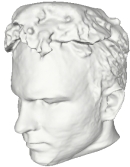Digital sculpture
In digital sculpture , in contrast to conventional sculpture, the sculpture is not processed by hand, but by a mainly automatic CNC processing system . The resulting image is either modeled layer by layer in the 3D printing process , or machined from a block of material by removing material from a CNC milling machine or CNC lathe.
Digital sculpture is thus an area of digital art .
The 3D scan
In order to be produced by a computer-controlled machine, a digital three-dimensional model is first required for an object to be realized in this way. This model usually consists of the * .obj, * .ply or * .stl format . These are point clouds, of which each point on the body has a length, width and height value, with three or more such points being connected to two-dimensional surfaces and these in turn being unified into a three-dimensional model (see also meshing ). The creation of such a virtual 3D model is done either directly on the computer by modeling in appropriate 3D graphics programs , or by CAD .
A 3D scan can also be carried out to create a digital 3D copy of real people, animals or objects. The 3D scanner used here mostly works without contact by scanning with one or more laser beams , but can also be CNC-controlled by scanning . The three-dimensional scanning often takes place in several individual views. For example, when scanning complex bodies, it can be useful to scan them from more than one side (front, back, right, left, top, bottom and, if necessary, views in between).
Editing with the computer
After the 3D scanning has been completed, the individual scans are combined on the computer to form a finished 3D model. The mesh file created with it has the advantage that it can be artistically changed virtually with the appropriate 3D programs. So it is e.g. B. possible to add a hat, glasses or any number of other variations of the original when creating a bust , the head of a scanned person. This step of computer processing is often referred to as the "actual digital sculpture".
Machine manufacturing
After the completion of the virtual 3D model, it is sent to a CAM program. If a CNC machine is intended for the production of the real sculpture, the CAM program now translates the mesh file into milling paths, which the CNC milling machine or CNC lathe follow exactly as specified. In this way, lane by lane, or in the case of 3D printing, layer by layer, the finished 3D object is produced.
3D printing has the advantage that internal structures can also be displayed in the model that a milling cutter would not be able to achieve. However, the choice of materials for 3D printing is limited, so plastic or powder materials are usually used. With CNC milling, the choice of material is almost unlimited, as almost any material can be machined with a suitable milling cutter. The desired surface quality has a decisive influence on the milling time. The finer the surface, the smaller the milling cutter has to be, and the more paths it has to travel at smaller distances from one another.
Web links
- Christian Lavigne: Digital Sculpture. On: sculpture.org , translation of La sculpture numerique , published in September 1998.
- The robot as a sculptor. On: euronews.com of February 24, 2014


